Earthworm Dissection

*If you
were absent and missed the lab, click
HERE for a video of the earthworm
dissection.
The following is a classification of a
species in the earthworm family Lumbricidae.
This common species is Lumbricus terrestris also
known as the night crawler or dew worm.
|
Kingdom |
Animalia |
|
Phylum |
Annelida |
Class |
Oligochaeta
or
Clitellata |
|
Order |
Megadrilacea |
|
Family |
Lumbricidae |
|
Genus |
Lumbricus |
|
Species |
terrestris |
Lab Objectives:
• Describe
the appearance of various organs found in the
earthworm.
• Name the organs that make up various systems
of the earthworm.
Background
Information:
Among the most familiar
invertebrate animals are the earthworms, members
of the phylum Annelida. The word annelida means
"ringed" and refers to a series of rings or
segments that make up the bodies of the members
of this phylum. Internally, septa, or dividing
walls, are located between the segments.
External segments are called metameres. There
may be more than 100 segments in an adult worm.
The clitellum is a swelling of the body found in
sexually mature worms and is active in the
formation of an egg capsule, or cocoon. Eggs are
produced in the ovaries and pass out of the body
through female genital pores. Sperm are produced
in the testes and pass out through tiny male
genital pores. During mating, sperm from one
worm travel along the sperm grooves to the
seminal receptacles of another worm.
Fertilization of the eggs takes place outside
the body as the cocoon moves forward over the
body, picking up the eggs of one worm and the
sperm of its mate.
The pumping organs of the circulatory system are
five aortic arches. Circulatory fluids travel
from the arches through the ventral blood vessel
to capillary beds in the body. The fluids then
collect in the dorsal blood vessel and reenter
the aortic arches. The earthworm takes in a
mixture of soil and organic matter through its
mouth, which is the beginning of the digestive
tract. The mixture enters the pharynx, which is
located in segments 1–6. The pharynx is a
muscular organ that pushes the food into the
next portion of the digestive system, the
esophagus. The esophagus, in
segments 6–13, acts as a passageway between the
pharynx and the crop. The crop stores food
temporarily before it moves on to the gizzard.
The gizzard is a muscular organ that grinds up
the food by muscular contractions similar to how
your stomach works. The mixture that the earthworm
ingests is ground up in the gizzard, then it is
moved into the intestine, which is the main
organ of digestion. In the
intestine, which extends over two-thirds of the
body length, digestion is completed and absorption
of the nutrients into the bloodstream takes
place. Soil particles and undigested organic
matter pass out of the worm through the rectum
and anus.
The nervous system consists of the ventral nerve
cord, which travels the length of the worm on
the ventral side, and a series of ganglia, which
are masses of tissue containing many nerve
cells. The nerve collar surrounds the pharynx
and consists of ganglia above and below the
pharynx. Nervous impulses are responsible for
movement and responses to stimuli. Each segment
contains an enlargement, or ganglion, along the
ventral nerve cord. Excretory functions are
carried on by nephridia, which are found in
pairs in each body segment. They appear as tiny
white fibers on the dorsal body wall. The
earthworm has no gills or lungs. Gases are
exchanged between the circulatory system and the
environment through the moist skin by a process
of diffusion.
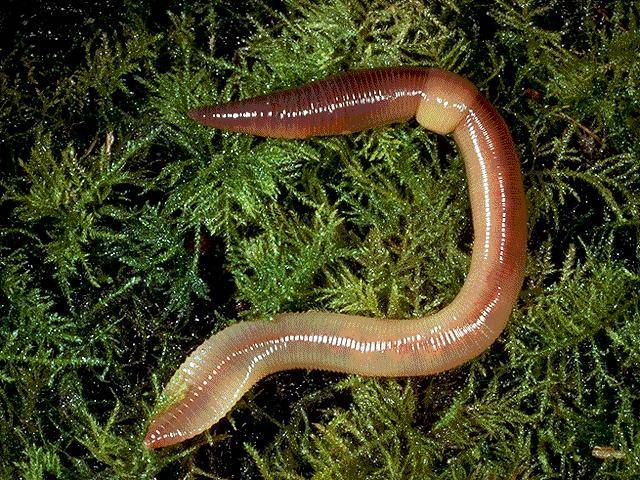
Procedure:
External Anatomy:
- Obtain an
earthworm from the lab table up front and gather your dissection
equipment. You will need a dissecting tray, scalpel, and
about 10-12 T-pins.
- Place earthworm in the dissecting tray
& rinse off the excess preservative. Identify the dorsal side,
which is the worm’s rounded top, and the ventral side, which is
its flattened bottom. Turn the worm ventral side up, as shown in
the diagrams below.
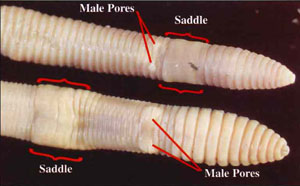
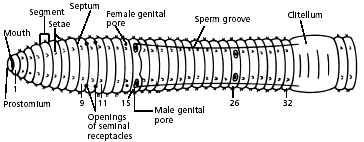
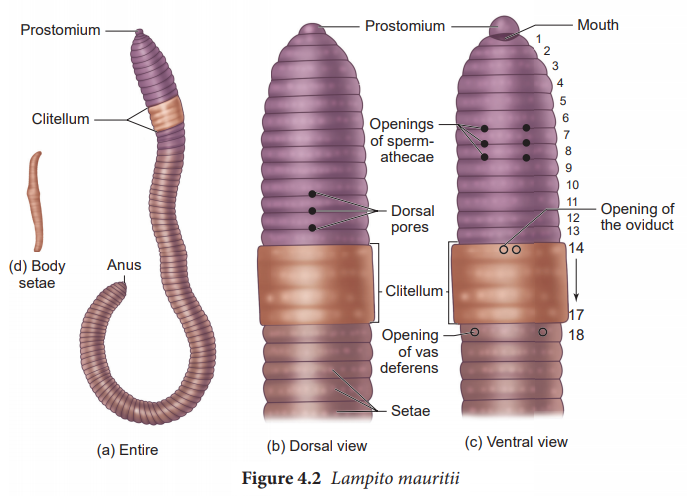
-
Use a hand
lens as you observe all parts of the worm, externally and
internally. Locate
the conspicuous clitellum, a saddle-like swelling on the dorsal
surface. The clitellum produces a mucus sheath used to surround
the worms during mating and is responsible for making the cocoon
within which fertilized eggs are deposited. The anterior of the
animal is more cylindrical than the flattened posterior and is
the closest to the clitellum. The ventral surface of the
earthworm is usually a lighter colour than the dorsal surface.
The mouth is located on the ventral surface of the first segment
while the anus is found at the end of the last segment. Find
the anterior end by locating the prostomium (lip), which is a
fleshy lobe that extends over the mouth. The other end of the
worm’s body is the posterior end, where the anus is located.

-
Locate the
clitellum, which extends from segment 33 to segment 37. Look for
the worm’s setae, which are the minute bristle-like spines
located on every segment except the first and last one. Run your
fingers over the ventral surface of the earthworm’s body. You
should be able to feel bristle-like setae used for locomotion.
-
Refer again to the diagram of the ventral
view of the worm to locate and identify the external parts of
its reproductive system. Find the pair of sperm grooves that
extend from the clitellum to about segment 15, where one pair of
male genital pores is located. Look also for one pair of female
genital pores on segment 14. There is another pair of male
genital pores on about segment 26. Try to find the two pairs of
openings of the seminal receptacles on segment 10. Note: These
openings are not easy to see.
Internal Anatomy
-
Hint: Position
your preserved earthworm dorsal side up and pin it down through
the first segment and then again further back behind the
clitellum. Cut a slit in the dorsal surface near the
posterior pin. Use the scalpel to extend the cut forward
to the first segment. Be careful not to cut too deep.
Starting at the first segment, cut the septa (thin membranes)
that internally divide the segments, so the skin can be laid
flat. Use additional pins to hold the integument open and
expose the organs. Continue to lay the skin back until you
have uncovered a centimeter or so of the intestine.
- Turn the worm dorsal side up. Using the
scalpel, make a shallow incision in the dorsal side of the
clitellum at segment 33. CAUTION: Scalpels are very sharp. Using
your fingers and scalpel, spread the incision open, little by
little. Separate each septum from the central tube using a
T-pin, and pin down each loosened bit of skin. Continue the
incision forward to segment 1.
- Use the diagram below to locate and identify
the five pairs of aortic arches, or hearts. Then find the dorsal
blood vessel. Look for smaller blood vessels that branch from
the dorsal blood vessel.
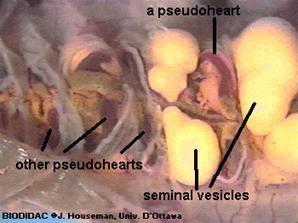
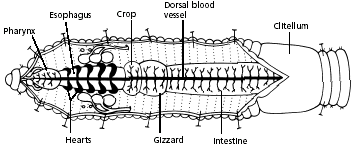
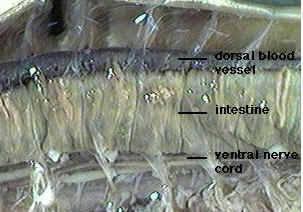
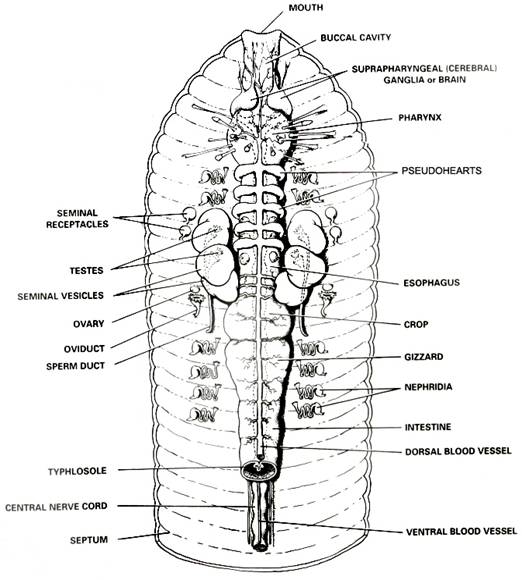
Digestive System
- The earthworm is an
example of a foraging herbivorous annelid, obtaining food by
eating its way through the soil and extracting nutrients from
the soil as it passes through the digestive tract.
-
Hint: Starting at the anterior end, locate
the muscular pharynx (food ingestion). This is followed by
a tube-like esophagus which terminates in a crop (the wider
organ) which serves as a storage stomach. Posterior to the
crop you will find the gizzard. Gently press on the crop
and gizzard to test their firmness. While the crop is soft
and thin, the gizzard is muscular (soil is ground up and churned
within the gizzard). The gizzard is followed by a long
intestine in which both digestion and absorption occur.
Undigested material is voided through the anus.
- Locate the digestive tract, which lies below
the dorsal blood vessel. Refer to the diagram above to locate
the pharynx, esophagus, crop, gizzard, and intestine.
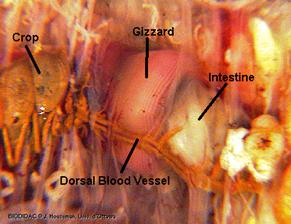
-
To find organs of the nervous system, push
aside the digestive and circulatory system organs. Use the
diagram below to locate the ventral nerve cord. Trace the nerve
cord forward to the nerve collar, which circles the pharynx.
Find one pair of ganglia under the pharynx and another pair of
ganglia above the pharynx. The ganglia above the pharynx serve
as the brain of the earthworm.
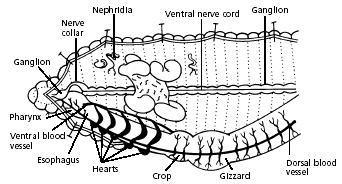
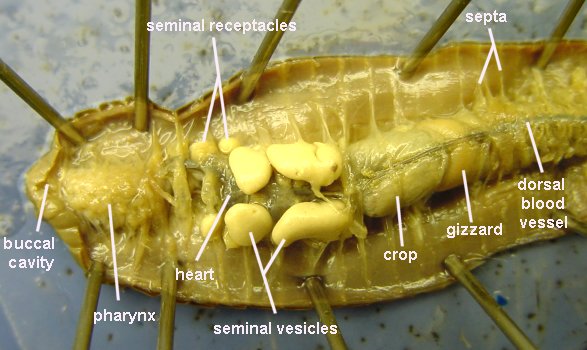
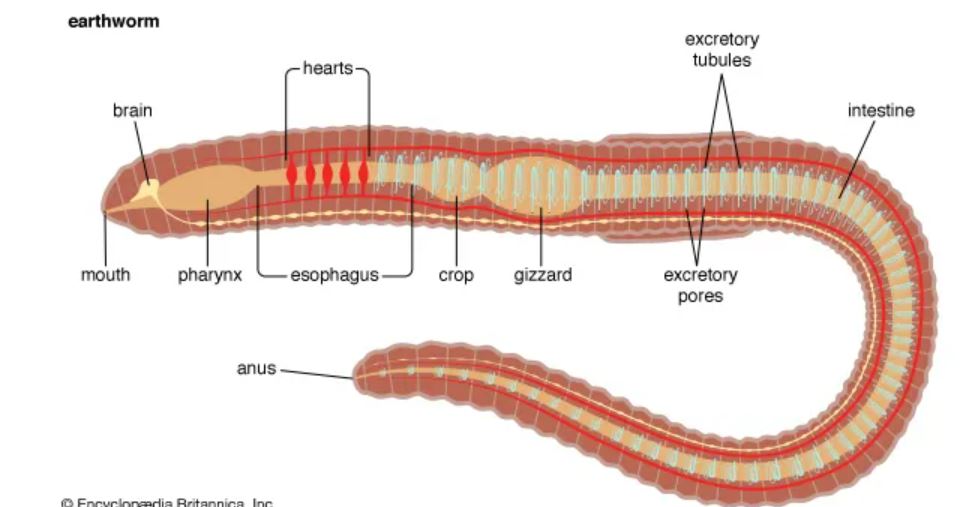
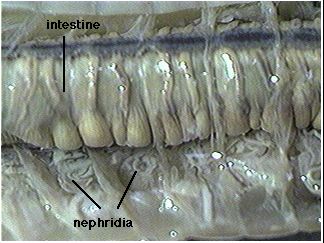

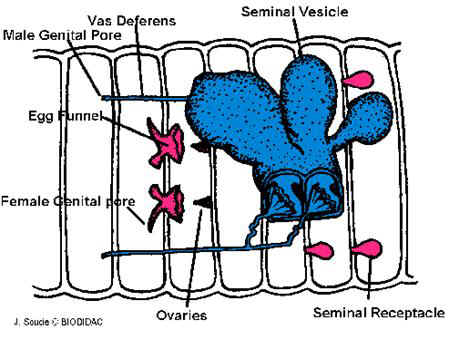
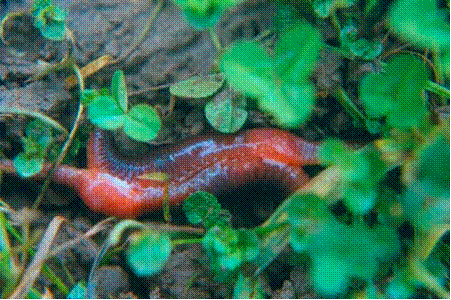
- Dispose of your materials according to the
directions from Mr. Breitkreutz

- Clean up your work area and wash your hands
before leaving the lab.
Click
HERE to learn more about Earthworms.
Click
HERE
to do an Earthworm Quizlet
Click HERE for an
Annelida Handout
Click HERE to learn more
about what will be on the Lab Quiz.



















